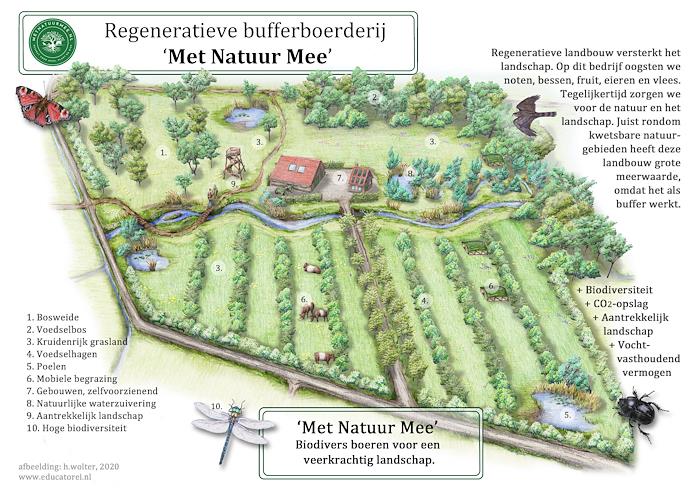In short
- Twente is struggling with soil degradation and has had two arid summers
- The traditional way of agriculture leads to soil degradation, many nitrogen emissions and does not benefit biodiversity
- The regenerative farm that Sanne Beld is starting up is tackling all these problems by working with nature
Global Goal

“We need a drastic change in our current agricultural system”, says Sanne Beld, founder of “Met natuur mee”. “The reports on biodiversity loss and climate change are real. We are already severely affected by the problems they create, such as the extreme drought in Twente of the past two summers and the nitrogen crisis.” The solution to these problems is regenerative farming, according to Sanne Beld. A regenerative farm aims to enable the restorative capacity of natural processes and to strengthen it. This will prevent soil depletion and degradation while also contributing to biodiversity, which is important for the survival (and controlling) of certain animal and plant species. Balance is key, and nature can best take care of this itself. We should not underestimate the importance of this, according to Sanne: “It is no longer just about special butterflies or beautiful flowers. It’s about our survival.”
Regenerative agriculture requires a way of working that is different from what we are used to, says Sanne. “We should work together with natural processes. It is based on perennial plants and trees, so it takes a while before you can harvest them.” This approach, therefore, requires more patience and will initially yield less than traditional agriculture. Once it is up and running, however, it is even possible to have a bigger harvest than with traditional agriculture according to Sanne. “The problem is that our soil is already so degraded by the current way of agriculture. It will take time to restore the soil to healthy, living soil. It also takes time to restore biodiversity.” Is it possible? Certainly! Says Sanne, this already been proven in several places around the world: “It has become clear that we can repair and establish a lot with this regenerative agriculture in just a few years.”

Only natural resources are used in regenerative agriculture for improving and cultivating the soil. “In the start-up phase, cows and chickens are used to improve soil health. No fertilisers or poisons are used. We are working towards a natural balance and biodiversity is an important part of this.” Working with nature will have positive effects on our environmental impact in general. The landscape will become more resilient and tolerant, which will ultimately combat climate change. The effects of a regenerative farm are more CO2 storage in the soil, greater moisture retention capacity and high biodiversity.
Sanne is aware that this “agricultural transition” may not be easy and will take time. Still, it is certainly necessary according to her. “The way we handle our raw materials right now will lead to a dead-end, that is very clear.” The regenerative farm that “Met natuur mee” is setting up is still in the start-up phase. To give an idea of what such a landscape looks like, Sanne had her vision put on paper (see image). Sanne is currently still looking for a location where she can make this a reality. “We have already started with a part of it, the chickens. These are kept on Staatsbosbeheer ground. The chickens are moved daily, since this mobile way of keeping livestock is an important part of regenerative farming. This way ensures that manure is evenly distributed over the ground and that the grass is not overgrazed.” In regenerative agriculture, nature and farmer live in harmony.
Related article(s)
Not only the way of farming has to change. Sanne emphasises that the market must also change. “This new way of farming focuses on having less export and more local food through direct sales.” This will benefit the climate because food is not shipped all over the world. It also benefits farmers as they will have more control over their prices. Because of that, Sanne thinks we need more farmers, rather than fewer, who do things differently. But it is not possible without consumers that are willing to pay the added value. The farmer cannot change if the consumer does not change his buying habit; it must come from all of us. Finally, Sanne Beld says: “I would like young people to choose to become farmers again because it is something that we are all proud of. The problem now largely lies with agriculture, but so does the solution.” Pioneers that show how things can be done differently are now urgently needed.
Date: 4 March 2020 |
Source of tekst: twente.com |
Author: twente.com





